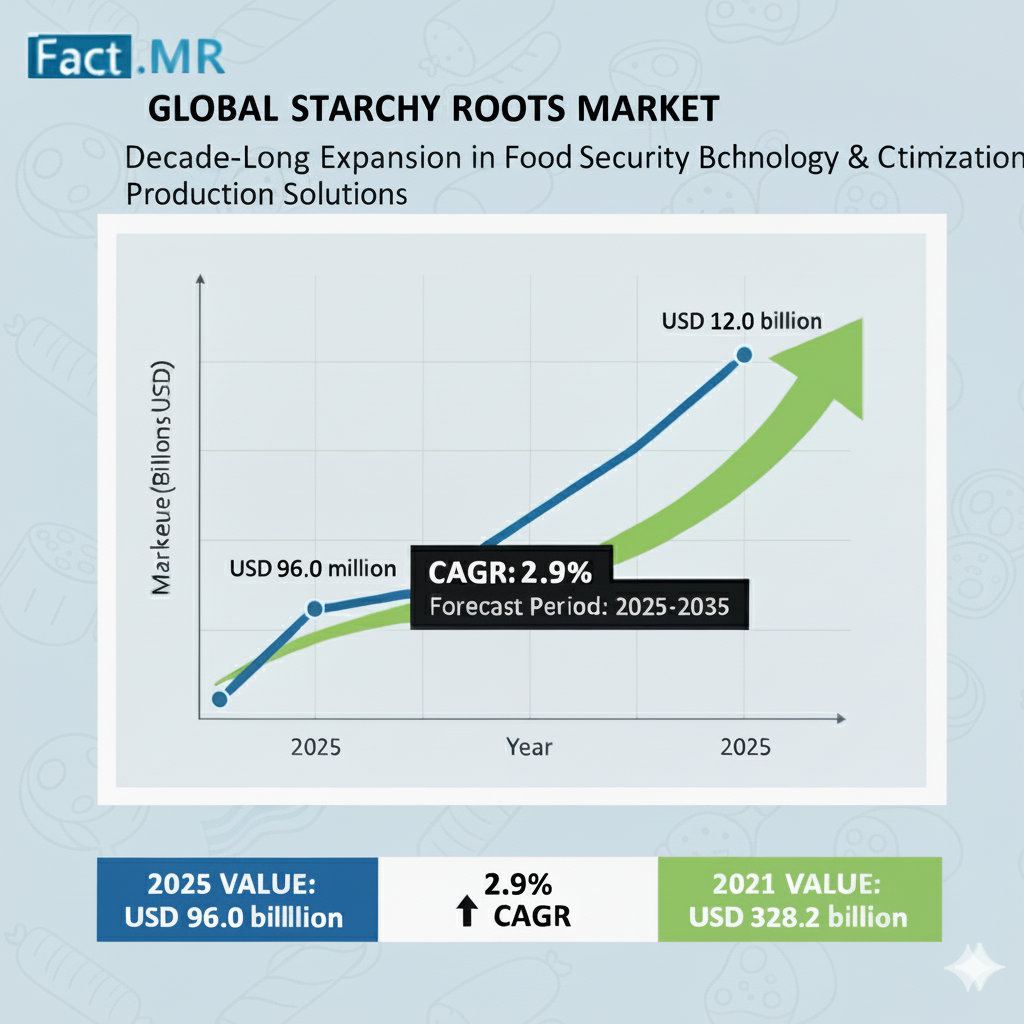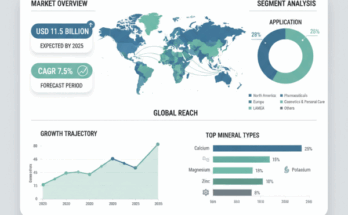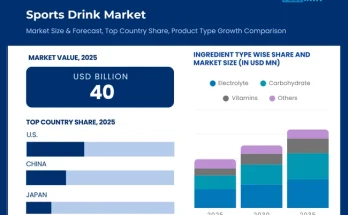The starchy roots industry stands at the threshold of a decade-long expansion trajectory that promises to reshape food security systems, industrial processing applications, and agricultural value chains worldwide. The market’s journey from USD 96.0 billion in 2025 to USD 128.0 billion by 2035 represents substantial growth, the market will rise at a CAGR of 2.9% This marks a defining period in the global food and agricultural sectors as starchy roots evolve from basic commodities to strategic nutritional and industrial assets.
A Decade of Measured but Powerful Growth:
The decade between 2025 and 2035 will see the starchy roots industry enter a dual-phase growth trajectory. During the first half (2025–2030), the market is expected to climb to USD 108.5 billion, representing USD 12.5 billion in value addition and accounting for 39% of total decade expansion. This early phase will be driven by accelerated adoption of cassava-based systems, bolstered by food security initiatives, sustainable carbohydrate sourcing, and expanding processing technologies across Asia Pacific, Latin America, and Africa.
The second half (2030–2035) will build upon this foundation, adding USD 19.5 billion in market value and contributing 61% of total decade growth. This phase will mark the mainstream integration of advanced processing systems, automated manufacturing platforms, and large-scale agricultural digitalization. The evolution will enable diversified applications in food manufacturing, livestock feed production, and industrial processing, making starchy roots central to the next generation of global food systems.
Cassava at the Core of Market Expansion:
Cassava continues to dominate the market landscape, capturing an estimated 46% share due to its nutritional density, starch flexibility, and adaptability across climates. Food manufacturers and agricultural processors increasingly favor cassava systems for their 95–98% processing efficiency, cost optimization, and integration compatibility with modern manufacturing networks.
The potato starch segment (34% share) follows closely, maintaining strong momentum in specialty food and industrial applications where consistency and functionality are key. Meanwhile, yam and taro categories gain traction in niche food and nutraceutical sectors.
Food Applications Drive Market Dominance:
The food segment, commanding over 62% of market share, continues to lead demand due to population growth, rising nutritional standards, and global food security programs. Starchy roots are being adopted across functional foods, packaged food manufacturing, and ready-to-eat meal solutions for their role in enhancing texture, taste, and nutritional profiles.
Meanwhile, feed applications (23% share) are expanding steadily in livestock and aquaculture sectors, while industrial applications (15% share) are witnessing innovation in bioplastics, adhesives, and biofuel feedstocks—signaling a gradual move toward circular economy integration.
Regional Growth Leaders: Asia Pacific & Latin America Take the Lead:
The Asia Pacific region is projected to remain the fastest-growing hub, driven by rapid agricultural modernization, localized production strategies, and food industry expansion. Countries such as China, India, Indonesia, and Vietnam are expected to record double-digit adoption rates in cassava and potato-based processing systems, supported by strong governmental food security programs.
Latin America, particularly Brazil and Mexico, is emerging as a high-opportunity region with a projected CAGR of 3.0%. Mexico, with its expanding food manufacturing base and agricultural modernization projects, represents one of the most lucrative investment landscapes for global players.
Europe continues to display steady maturity, with Germany, France, and the U.K. anchoring demand through technology integration and sustainable agricultural systems. In the United States, the market is forecasted to grow at a 3.2% CAGR, led by modern food processing expansion and adoption of precision nutritional control systems.
Innovation Pathways and Revenue Opportunities:
Fact.MR identifies seven strategic pathways for manufacturers and investors to capitalize on the market’s upcoming transformation:
- Cassava Leadership (USD 3.8–5.1 billion revenue potential): Optimization of starch content, nutritional enhancement, and automated cultivation systems.
- Asia Pacific Expansion (USD 2.9–3.9 billion): Localization of production and technology transfer to reduce import dependencies.
- Food Segment Integration (USD 2.5–3.4 billion): Strengthening food application dominance through automation and compliance systems.
- Feed Application Diversification (USD 2.1–2.8 billion): Advanced nutritional processing for livestock feed and aquaculture applications.
- Industrial Application Innovation (USD 1.8–2.4 billion): Deployment of hybrid processing for eco-friendly industrial solutions.
- Processed Form Development (USD 1.6–2.2 billion): Expanding the processed segment with value-added food ingredient applications.
- Eco-friendly Agriculture (USD 1.4–1.9 billion): Sustainable farming practices aligned with global environmental regulations.
Competitive Landscape: Technology and Integration Take Center Stage:
The global market remains moderately concentrated, with 12–15 major participants controlling roughly 40% of global revenue.
- Thai Agri Foods, the market leader (4.5% share), sets the pace through cassava-based processing expertise and regional dominance in Asia.
- Cargill and Ingredion continue to expand their agricultural and nutritional portfolios through investments in sustainable starch innovations.
- Roquette, Avebe, and Tereos lead the innovation frontier with rapid development cycles and specialized food applications.
- Regional specialists like Tate & Lyle, Emsland, and KMC are deepening integration with local agricultural networks and food manufacturing systems.
Competition increasingly revolves around technological integration, system reliability, and environmental compliance, marking a shift from price-based competition to value-driven partnerships in supply chains.
Outlook: Shaping the Future of Global Food and Agricultural Resilience:
The starchy roots market’s expansion to USD 128 billion by 2035 underscores a structural evolution in global agricultural and food manufacturing systems. From addressing nutritional deficiencies and ensuring food security to enabling industrial innovation and sustainability compliance, starchy roots have become a cornerstone of the 21st-century agri-food economy.
As major players and regional manufacturers align strategies toward automation, nutritional optimization, and localized production, the decade ahead offers a compelling opportunity to lead in an era of resilient, efficient, and sustainable crop-based solutions.
For food processors, agricultural engineers, and industrial manufacturers, 2025–2035 represents not just growth—but the reinvention of global carbohydrate sourcing and processing technology.
Browse Full Report-https://www.factmr.com/report/919/starchy-roots-market



